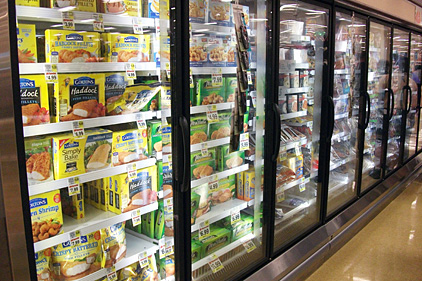
|
| Supermarkets have lots of refrigerated equipment, so the ability to detect refrigerant leaks is especially important with so many perishable products needing to maintain proper temperature. |
Today, new refrigerant replacements are being introduced to the market in an effort to make headway on global warming potential (GWP) and direct emissions reductions, and to help companies find a balance between environmental responsibility, energy savings, and system resiliency.
Responsible Use
The principles of responsible use include:
• Containing refrigerants in tight systems and containers to minimize release into the environment;
• Minimizing the amount of refrigerant in a system without sacrificing performance;
• Designing, installing, and operating equipment and systems to optimize energy efficiency;
• Sizing equipment to match an application’s specific needs;
• Minimizing the number of fittings through which refrigerant flows to reduce the number of potential leak points;
• Leak-testing new installations; and
• Monitoring application performance to minimize operational refrigerant leaks.
For supermarkets and other food retail locations that largely depend on refrigeration capacity and performance and often on very large refrigeration systems, the prevention of refrigerant leaks is critical not only because of the negative environmental impact of such leaks, but also for reasons of cost. Many systems hold hundreds of pounds of refrigerant at one time, so even the smallest leak can mean significant, unexpected costs in refrigerant loss and environmental health. Responsible use means conducting routine maintenance to ensure refrigerant life and keeping leakage from draining the bottom line.
Monitoring
Keeping track of refrigerant levels alone is not a sufficient or accurate method of leak detection, as the system receiver is influenced by many variables, including outside temperature, split condenser, and heat reclaim. On any given day, the level reading may fluctuate, thereby making it difficult to detect a reduced receiver level, especially when a leak is small and occurs over the course of several weeks or even months. In these cases, by the time a leak is suspected, substantial loss can have already occurred, and the task of locating the point(s) of leakage is more difficult and tedious. Often, it is very difficult to know where or when the gas was lost. Even a handheld detector may not pick up on this kind of leak as the leak may only occur at specific times, such as during defrost or heat reclaim.
The best way to detect leaks is through real-time monitoring which requires a detector that operates 24/7, constantly sampling the surrounding air. In supermarkets, where the piping and systems are located throughout the store, it is advantageous to employ a detector that can sample the air in strategic locations such as refrigeration pits, racks, air handlers, and cases/coolers/freezers.
Detectors
This can be accomplished through two primary types of detectors available on the market today.
One is an infrared detector that covers a refrigeration zone by sampling through a tube, which is then tested in a chamber known as a bench.
Another is a solid state detector that is placed at a strategic location and signals to the facility’s energy management system (EMS) via wired connection.
In addition, some local regulations require enclosed refrigerated areas, such as walk-ins and prep areas, to have some method to warn people working in these areas to evacuate if a refrigerant leak occurs. Some refrigerants can cause asphyxiation in enclosed environments and are flammable. This requires supplemental use of an audible and visual alarm device that is activated when a set parts per million (ppm) level is reached.
Regardless of which type of leak detector is ideal for an application, they are designed to deliver ppm data to an EMS controller to monitor and determine any required action. This can include local alarming and safety shutdown, plus the ability to transmit the alarm to appropriate parties and maintain a log of times and levels for future review. Both detectors can keep a history of all alarms. These capabilities are critical for an on-site operator or technician to take immediate action as needed, and provide the store’s history and patterns, which can be important in determining and aiding in system repairs.
EDITOR’S NOTE: This material was prepared by Danfoss which, through its Electronic Delivered Services business, offers customers a dashboard on the history of multiple operational data points including refrigerant liquid levels (in percentage), refrigerant loss (in ppm), refrigerated area temperature levels, refrigerant rack pressure levels, power consumption, and other options.
Publication date: 10/21/2013









